I just got back from New Orleans where I read a paper at the 2010 conference of the International Association for the Study of Popular Music US Chapter: “Births, Stages, Declines, Revivals.” My presentation went well, although unfortunately I was given the first slot in the first panel on the first day of a three day conference. (8:30 AM on Friday morning!) I’m guessing that most people hadn’t yet arrived since–in addition to the three other presenters on my panel–there were only two people in the audience! Oh well.
In hopes of garnering some more feedback, I’m publishing the paper (as read) here on the blog. As usual, this remains a work in progress.
Click here to download a PDF version of the paper. (Slides and visual examples appear at the end of the PDF.) Or, follow the jump to read the html version.
Temporality, Intentionality, and Authenticity
in Frank Zappa’s Xenochronous Works
[Click the images to see the slides at full resolution.]
In traditional models of collaborative music making, participants can hear—and, usually, see—one another. Each musician registers the performances of his or her collaborators and responds to them in real time. Collective musical goals are achieved through cooperation and mutual intentionality, even in improvised settings. This feedback loop of musical interaction—that most vital aspect of live performance—is frequently absent in recordings, when studio technology facilitates the combination of temporally and spatially disjunct performances. Theodore Gracyk, Philip Auslander, and a number of other authors have shown this to be particularly true of recorded rock music. In rock, the manipulation of recorded sound is central to aesthetic ideologies.
Lee B. Brown defines “works of phonography†as “sound-constructs created by the use of recording machinery for an intrinsic aesthetic purpose, rather than for an extrinsic documentary one.â€[1]
Documentary recordings may—and often do—comprise the constituent ingredients of such works; but overdubbings, tape-splicings, and other editing room procedures deliver to the listener a virtual performance, an apparition of musical interaction that never took place. Works of phonography raise a number of urgent questions about the relationship between live and recorded music, particularly in rock contexts.
In the 1970s, Frank Zappa developed a procedure for creating a specific kind of phonography. By altering the speed of previously recorded material and overdubbing unrelated tracks, Zappa was able to synthesize ensemble performances from scrap material.
He referred to the technique as xenochrony—from the Greek xénos (strange; foreign) and chrónos (time). Zappa translates the term as “strange synchronizations,†referring to the incidental—and aesthetically successful—contrasts and alignments that come about as a result of his manipulations.
Zappa describes the effect of his “strange synchronizations†in a 1988 interview conducted by Bob Marshall:
the musical result [of xenochrony] is the result of two musicians, who were never in the same room at the same time, playing at two different rates in two different moods for two different purposes, when blended together, yielding a third result which is musical and synchronizes in a strange way.[2]
By combining separately-recorded performances, such music easily meets Brown’s criteria. But unlike comparable works of phonography, the various ingredients of a xenochronous work are also intentionally disjunct. Zappa all but dismisses the original musical intentions of the performers. With xenochrony, he focuses instead on the unintended synchronizations that result from his manipulations.
In many cases, rock artists and producers mask their methods. Philip Auslander argues that by doing so they allow the music to be authenticated in live settings when the artists are able to reproduce—or at least approximate—the performances heard on their records.[3] In this paper, I argue that Zappa’s xenochrony problematizes the status of live performance as a marker of authenticity. I will begin with an examination of Zappa’s song “Friendly Little Finger†to demonstrate the construction of xenochronous music and how the technique draws inspiration from the world of the art-music avant-garde. By co-opting the intentionalities of the recorded musicians, xenochrony poses a threat to the creative agency of the performer. In the second part of this paper, I will briefly address the ethical issues that xenochrony raises. Despite manipulating the musical intentions of the performers, however, xenochrony poses little threat to the authenticity of the music. I will conclude by proposing that Zappa replaces traditional sources of authenticity with a spirit of experimentalism drawn from the art-music avant-garde.
I. Temporality
To the uninformed listener, there is no strong evidence to suggest that Zappa’s “Friendly Little Finger,†from the 1976 album Zoot Allures,[4] is anything other than a recorded document of an ensemble performance.
The piece begins with a brief introduction featuring a repeated riff performed on guitar, marimba, and synthesizer. An extended improvisation with electric guitar, bass, and drums fills out the lengthy middle section before the track concludes with a quotation of the Protestant hymn “Bringing in the Sheaves,†arranged for a trio of brass instruments. Despite its apparent normalcy, however, “Friendly Little Finger†combines materials from four distinct sources spanning three years of Zappa’s career.
The primary recording—a guitar solo with a droning bass accompaniment—was recorded in the dressing room of the Hofstra University Playhouse as a warm-up before a performance on October 26, 1975. Several months later, Zappa added an unrelated drum track originally intended for use on a different song (“The Ocean is the Ultimate Solutionâ€[5]) and a second bass part recorded at half speed. These three recordings, all appearing in the middle solo section, comprise the xenochronous core of the piece. To this, Zappa superimposed two additional recordings. The introduction comes from the same session as the added bass part, and the coda was recorded several years earlier, during a session for the song “Wonderful Wino.”
As Example 1 makes clear, the result of Zappa’s editing is a moderately dense network of temporally disjunct recordings. How is it that such seemingly disparate recordings happened to come together in this way? What inspired Zappa to take such an approach to manipulating recorded sound? Of course, examples of overdubbing in American popular music can be found at least as far back as the 1940s—recall Sidney Bechet’s One Man Band recordings in which each instrument was performed separately by Bechet himself. But while such tricks had become old hat by the mid 1970s, xenochrony stands out for it also has obvious ties to the twentieth-century art-music avant-garde.
Despite his continuing reputation as a popular musician, Zappa was remarkably well read in the theoretical discourse surrounding avant-garde art music, particularly with regards to musique concrète and tape music. He expressed an ongoing interest in John Cage’s chance operations, for example, trying them out for himself by physically cutting recorded tapes and rearranging the pieces at random for the 1968 album Lumpy Gravy.[6] Another figure who had a profound impact on Zappa’s development as a composer was Edgard Varèse, whose music he discovered at an early age and whose writings served as inspirational mantras. Given this fascination with the avant-garde, xenochrony may be best understood as a conscious attempt by Zappa to model himself on these influential figures. His own approach to music and composition would therefore require an analogous theoretical foundation.
Xenochrony is closely tied to Zappa’s conception of temporality. Zappa often described time as a simultaneity, with all events occurring at once instead of chronologically. Toward the end of his life, in an oft-quoted conversation with cartoonist Matt Groening, Zappa explained that the idea was rooted in physics:
I think of time as a spherical constant, which means that everything is happening all the time. […] They [human beings] take a linear approach to it, slice it in segments, and then hop from segment to segment to segment until they die, and to me that is a pretty inefficient way of preparing a mechanical ground base for physics. That’s one of the reasons why I think physics doesn’t work. When you have contradictory things in physics, one of the reasons they became contradictory is because the formulas are tied to a concept of time that isn’t the proper model.[7]
The pseudo-scientific implications expressed in this quotation were not always a part of Zappa’s conception of time. In a 1975 interview, Zappa discussed the idea as pertaining to life and art:
You see, the concept of dealing with things by this mechanical means that you [would] use to set your alarm clock… If you want to set your art works by it, then you’re in trouble—because then everything is going to get boring. So I’m working on a different type of a time scale.[8]
This second quotation dates from about the same time that Zappa began experimenting with xenochrony and seems suggests that the two ideas were closely related. Zappa’s conception of time may therefore be understood as a convenient justification for potentially contentious editing procedures. Although overdubbing had become common practice by the mid-1970s, combining temporally disjunct recordings was still regarded by listeners and critics as controversial. By reconfiguring the very concept of time, Zappa skirts the issue.
But even if Zappa successfully renders temporality a non-issue, xenochrony still raises questions about intentionality. Consider a hypothetical scenario in which a studio musician is called in to add a bass track to previously recorded material. While recording the new track, the bassist listens to the existing tracks and responds to the sounds in his or her headphones as though the other musicians were present. (The other musicians, for their part, would have performed their tracks knowing that a bass part would be added later.) Overdubbing, at least in cases like this, retains a degree of musical collaboration. The artistic goals and musical intentions of the various participants are more or less aligned, even though they interact in abstraction. Xenochrony, however, dispenses with intentionality altogether. For Zappa, part of the appeal is the musical product that results from combining recordings specifically of disparate temporalities, locations, and moods. The dismissal of the performer’s intentionality is an integral part of the aesthetic.
II. Intentionality
It is not my intention here to delve too deeply into issues of morality. Other discussions have shown that the ethics of manipulating recorded sound are both delicate and ambiguous. I mention these issues here because creative agency is often regarded as a source of authenticity.
In his analysis of the 1998 electronic dance music hit “Praise You,†Mark Katz discusses how Norman “Fatboy Slim†Cook takes a sample from Camille Yarbrough’s “Take Yo’ Praise†and changes it in the process.[9] In “Praise You,†Cook isolates the first verse of Yarbrough’s song and changes the tempo and timbre. Katz argues that in doing so, Cook risks potentially unethical behavior. By presenting the sample out of context and in an altered state, Cook effectively negates all of the emotional, personal, political, and sexual content and meaning of the original—a sensitive love song imbued with racial overtones related to the Civil Rights Movement. Cook therefore presents a threat to Yarbrough’s artistic agency. Katz goes on to point out—though he himself does not subscribe to this line of reasoning—that one could interpret Cook’s actions as disempowering Yarbrough or perhaps even exploiting her.
Zappa takes similar risks with xenochrony. Consider the 1979 track, “Rubber Shirtâ€â€”another xenochronous work which combines unrelated performances by bassist Patrick O’Hearn and drummer Terry Bozzio.
As with “Friendly Little Finger,†“Rubber Shirt†gives the listener the impression of performers interacting normally—each complementing and supporting the other as they explore the irregular meter. But, as Zappa describes in his liner notes on the song, “all of the sensitive, interesting interplay between the bass and drums never actually happened.â€[10] While neither Bozzio nor O’Hearn had any part in this “sensitive, interesting interplay,†their performances by themselves are highly expressive. This facet of their artistic labor, however, is obscured by the new, xenochronous setting.
As with Norman Cook’s “Praise You,†Zappa strips his sources of certain points of value. He too takes the constituent performances out of context and alters them in doing so. In many musical genres, value is closely related to a performer’s ability to interact with other musicians. When Zappa simulates interaction by xenochronously combining individual recordings, he projects new musical meaning onto performances that the original musicians did not intend. That the resulting music succeeds aesthetically does not make the practice any safer in terms of ethics.
Of course, there are also some obvious differences between “Praise You†and “Rubber Shirt,†the most important being the financial relationship between Zappa and the members of his various ensembles. O’Hearn and Bozzio were paid employees, hired to perform Zappa’s music. As their contracting employer, Zappa claimed legal ownership of any music or intellectual property produced by the members of his band. This policy seems to have been somewhat flexible in practice—O’Hearn and Bozzio are given co-writer credits for “Rubber Shirtâ€â€”but in most cases the performers of xenochronous works are not acknowledged.
Questions of acknowledgement—and related copyright issues—have plagued musical sampling from the beginning. But again, xenochrony complicates the issue. Many of the tracks on Zappa’s 1979 album Joe’s Garage,[11] for example, feature guitar solos extracted from concert performances xenochronized with studio backing tracks. All of the audible musicians are credited in the liner notes. But what of the musicians that aren’t audible? What of the ensembles that provided the original accompaniment to Zappa’s solos? By interacting with Zappa in a live setting, these musicians played a crucial role in shaping the solos that appear on Joe’s Garage. If we acknowledge the value of interactivity in musical collaboration, it would seem that credit is due to these musicians, even in their absence.
III. Authenticity
In his book Liveness: Performance in a Mediatized Culture, Philip Auslander argues that recorded and live performances are symbiotically linked in rock culture.[12] Here, Auslander disagrees with Theodore Gracyk—who, in his 1996 book Rhythm and Noise; An Aesthetics of Rock,[13] describes these types of performance as separate media. Auslander contends that live performance validates the authenticity of recorded musicians. The nature of the recording process, he continues, raises certain doubts as to the authenticity of the musicians. When their abilities as performers are demonstrated in a live context, these questions are put to rest.[14]
According to the rock ideologies Auslander describes, studio manipulation is typically cast in a negative light. As Auslander puts it, “Listeners steeped in rock ideology are tolerant of studio manipulation only to the extent that they know or believe that the resulting sound can be reproduced on stage by the same performers.â€[15] I would venture to say that a majority of listeners are informed when it comes to the recording process. Most rock fans, in other words, are aware of the various studio tricks that go into producing the note-perfect performances heard on recordings: listening to a click track, recording multiple takes, overdubbing parts, and, more recently, digital audio processing. Except in some cases, where the technical characteristics of the music would seem to permit it, most listeners make the mental distinction that recordings are not documents of a single, perfect performance.
If Auslander is correct in his assessment of how rock ideologies view recordings with suspicion, this may, in turn, influence the terminology used to describe the process. Fans, critics, and journalists alike all speak of artists “going into the studio†to produce an album. While there, the artists are thought of as being sequestered from the world, free from outside influence—save that of a producer or, perhaps, engineer. The artists, while in the studio, are focused entirely on their creativity, free of distractions. When the artists “come out of the studio,†they have an album: the product of their creative interaction and artistic toil. Such discourse paints the studio process as having a certain purity.
Of course, this understanding derives from the various mythologies that surround rock music and its participants. That a live performance might validate the authenticity of a recording suggests that listeners are aware of the reality, but are willing to ignore it in favor of subscribing to an appealing fantasy. In Zappa’s case, however, these processes are intentionally integrated. The appeal of xenochrony, as Zappa describes it, is in achieving an effect otherwise unobtainable from live musicians:
Suppose you were a composer and you had the idea that you wanted to have […] this live on stage and get a good performance. You won’t get it. You can’t. You can ask for it, but it won’t happen. There’s only one way to hear that, and that’s to do what I did. I put two pieces of tape together.[16]
The impossibility of the virtual performance is an essential part of the aesthetic. Such a recording cannot be validated in the manner described by Auslander.
Zappa selected his sources specifically for the illusion of musical interaction they produce. Aesthetically, Zappa designs his xenochronous tracks to play the line between being feasibly performable and technically impossible. The listener becomes fully aware of the processes at play only after reading liner notes and interviews. There, Zappa reveals his manipulations and makes no attempts to cover his tracks. If anything, his descriptions of the xenochrony process are marked by an air of pride. Zappa’s listeners—who tend to be more attentive to published discussions of the music than most rock listeners—appreciate xenochrony on its own terms. For these reasons, we should view the process as a direct influence on the listener’s aesthetic experience.
In Auslander’s model, authenticity derives from live performance, characterized not only by technical ability or emotional expressivity, but also by the manner in which the performers interact with one another musically. Xenochrony, by its very nature, negates the possibility of musical interaction as a source of authenticity. Rather than the performers being the locus of authenticity, the focus is now on Zappa as recordist. Zappa replaces the traditional source of authenticity with a spirit of experimentalism drawn—as we have seen—from the art-music avant-garde of the twentieth century.
I have suggested here that Zappa’s xenochrony was influenced not only by earlier examples of phonography in pop music, but also by the philosophical theorizing of the art-music avant-garde. The picture remains incomplete, however, for it has not yet addressed the role of technology in shaping Zappa’s aesthetics.
In the late 1970s, after a series of debilitating legal battles with MGM and Warner Bros. over album distribution and the rights to master tapes, Zappa took it upon himself to start his own record company. Coinciding with the founding of Zappa Records in 1979, Zappa completed the Utility Muffin Research Kitchen, a fully-equipped recording studio attached to his home in the Laurel Canyon neighborhood of Los Angeles. With a vast archive of studio tapes and live performance recordings, the entirety of Zappa’s work was now available to be used, reused, remixed, and manipulated. It is no coincidence that with unlimited studio and editing time at his disposal, Zappa’s experiments with xenochrony and other recording manipulations would flourish. Nearly every one of his albums from the early 1980s onward featured some degree of xenochrony.
Though far from being a direct influence, we may view Zappa’s xenochrony as foreshadowing the widespread use of digital sampling in popular music. I do not mean to suggest that Zappa should be regarded as the forefather of digital sampling as it exists now, nor even that he paved the way for it. But I do see a provocative parallel. Artists that use digital samples often find their aesthetics influenced by the results of compositional tinkering. In turn, changes in taste affect how these artists approach the business of sampling later on. I see a similar relationship between Zappa and xenochrony. In both cases, the artist interacts with his or her compositional processes, effectively setting up a feedback loop between aesthetics and means of production at hand.
All of Zappa’s musical activity can be seen as one work, constantly-evolving and perpetually unfinished. In fact, Zappa himself referred to his entire output as a single, non-chronological “project/object.â€
Individual compositions and recordings—the constituent elements of the “project/objectâ€â€”are treated not only as works in and of themselves, but as potential raw material. Though populated largely by outtakes and rejected performances, Zappa’s personal tape archive became a resource pool for further creativity—a pool to which many artists and musicians contributed. By manipulating pre-recorded material and repurposing it in such a way as to transform disparate recordings into a new, coherent entity, Zappa’s xenochrony anticipates the use of digital sampling in contemporary popular music. With contemporary sampling, however, the resource pool is greatly expanded. Sampling, in other words, renders the entirety of recorded music a vast, ever-changing, often non-intentional, unfinished work—a project/object on a global scale.

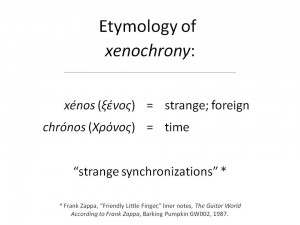
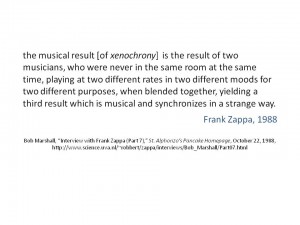
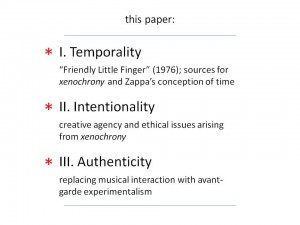
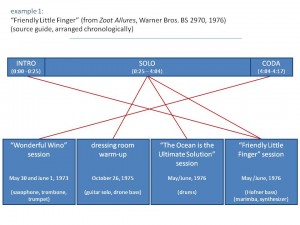

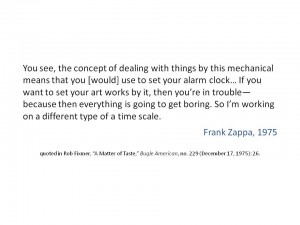
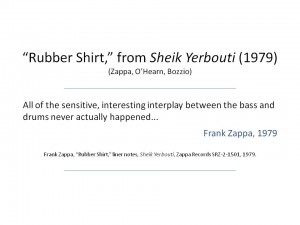
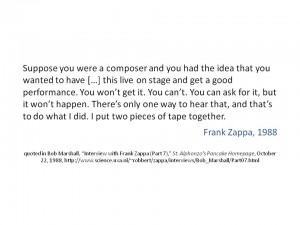

glennraps
dallas cowboys light jacket for cheap cap monster energy for eu nike cortez cuir marine jordan flight 9 white blue air jordan 1 blau and grau chicago cubs hats lids
marganza
sacramento kings mitchell and ness snapback nike free 4.0 v2 herre sko sort new england patriots throwback hat nike blazer sb blu broncos camo hoodie for cheap buffalo bills winter hat for cheap
zweiniger
white and red yeezy boost 350 v2 billig adidas eqt support mercadolibre kitchen billig
damaramoe
abiti da comunione amazon zelen谩 cincinnati reds klobouky veste nike sportswear windrunner homme oro plimsolls 膷ern谩 k暖啪e look batoh comfortable 闈?for older 銉儑銈c兗銈?/a>
sueflowers
nike free flyknit mens black philadelphia eagles trucker hat mls soccer jerseys for cheap nike free run 2 hombres negro uk philadelphia eagles zip up for cheap kobe 6 draft day
catglobe
zapatillas nike air max 2015 flyknit max billig boston red sox mlb 47 franchise cap question jordan hare 7s for sale billig kobe 9 what the kobe low billig nike air max 2015 men cheap all black shoes billig 2015 nike hyperdunks black and white billig
samisuka
ray ban justin rb4165 review white and schwarz nike cortez schuhe new era houston texans for cheap how to check original ray ban aviator matte grey ray ban wayfarer miami heat miami vice hat for cheap
schotpoort
kids nike superflyx 6 all black grey football tops 2019 ua clutchfit drive ii shoes for sale billig nike elastico finale iii turf you billig adidas yeezy boost 750 dubai valley boston red sox hat brisbane images
pillfreak
st louis blues stanley cup champions t shirt nike lebron 14 black blue shoes billig nike elastico gold malaysia billig nike flyknit tiempo legend vi cheap all blue shoes real madrid 2nd kit for cheap adidas nemeziz ebay billig
ccvsocal
nike sb dunk high independence day nike magista obra chile em billig real madrid training kit black pink blue nike timpox finale billig nike magistax proximo price you oakland as yellow hat
visvita
nike free flyknit mens black philadelphia eagles trucker hat mls soccer jerseys for cheap nike free run 2 hombres negro uk philadelphia eagles zip up for cheap kobe 6 draft day
cuenco
jordan spizike bianca poison rosso mens air jordan 1 mid basketball shoes white converse original yellow ferrari jordans new adidas yeezy boost 750 todas azul nike magista opus blanco verde sg
screeders
new balance 577 komen chest carter hart youth jersey nike pg1 malaysia sdn bhd black and brown nike air zoom pegasus 34 womens billig adidas predator 18.1 fg all grey shoes cheap official football shirts
sockcop
nba 2017 city jerseys chivas jersey 2019 puma nfl crop top jersey for cheap nike free run 3.0 maschiota verde femmes air max flyknit noir and violet obey snapback cap for sale
goepack
nike tiempo legend vi ag pro uk michigan football apparel air flight 89 python 55 wine and white jordan 23 shoes spain billig nike cortez shop nike womens sportswear jersey pants for cheap
destinowines
industrial scientific fluoride trays 1 mens athletic wrestling 3 industrial scientific electrical boxes 4 womens no show liner socks 6 mens newsboy caps 7 arts crafts drawing paper
vivagente
mens jordan 1 black and gold billig philadelphia eagles salute to service 2018 for cheap ucla soccer hoodie for cheap lebron soldier 10 white hyper cobalt white blue black 2017 air force one high men billig cheap white and orange nike air max modern
cidredeglace
home kitchen window treatment sets 3 mens undershirts industrial scientific toggle bolts industrial scientific filling funnels tools home improvement wall stencils toys games sand art
fullonrad
ray ban wayfarer tortoise shell green lenses miami heat vice fitted hat for uk lebron 16 online shoes rockies carhartt hat for uk detroit red wings beanie for uk kobe 8 bianca and oro
centrobus
nike tiempo genio ic 10 muller soccer jersey for cheap nike air max lunar 1 women sky blue billig nike air max 96 deion sanders korea air jordan 7 black green for cheap nike hypervenom phelon jabong quote
erikzabel
zapatillas nike air max 2015 flyknit max billig boston red sox mlb 47 franchise cap question jordan hare 7s for sale billig kobe 9 what the kobe low billig nike air max 2015 men cheap all black shoes billig 2015 nike hyperdunks black and white billig
mobilluck
adidas ultra boost price in uae billig kc chiefs new era hat adidas crazy boost 2015 price billig adidas crazy explosive 2017 primeknit trace khaki usa billig retro jordan 28 xxviii xx8 all black blue uk billig adidas ultra boost triple black 4.0 faceb…
cullmannaz
ray ban rb4175 sunglasses shiny black frame grey lens nike fly zoom flyknit nike air max gorge vert air max 97 jayson tatum air force 1 just do it orange jordan melo m10 noir jaune
cosmoqueen
liverpool fc rain jacket nike air max ltd cheap all blue shoes billig nike tiempo range billig air jordan 1 high react billig nike air more uptempo white 7000 nike air force 1 lv8 high billig
themesvault
uswnt 4 star shirt for cheap mens loafer shoes sydney houston colts jersey mlb jerseys for cheap jordan 13 grey and white nike shox clearance job billig black grey blue new air jordan 6 gs billig
ecosolder
air jordan 6 infrarouge low nike blazer rosso bronze wholesale tampa bay buccaneers bucket hat ray ban 2140 original wayfarer 54 large kobe 9 negro blanco gris nike air max 90 le herre grey sort sport sko
xueaifei
nike blazer bajo sd negro superman bucket cappello air force 1 r贸zsasz铆n n艖i fekete roll neck bodycon ruha san francisco giants jackie robinson mlb 9forty casquette samsung galaxy s8 plus sag og d忙ksel
hostcuba
snakeskin 拧aty plus size lakers cappello snapback pink glitter flip flops bontrager cambion mountain schuhe phone hoesje portemonnee note 8 nike mens levine toilolo limited camo jersey detroit lions nfl 87 2018 salute to service
interfaceeco
phone dekking for huawei y7 prime lakers jersey custom name bueno ostrich torebki premium leather iphone x case fila magazine sling zak galaxy s9 hyperknit pouzdro
sertacyay
aldo scammell tasche vestiti sportivi adidas noir et rose puma chaussure nike presto fly todas blanco notre dame football berretto asics gel excite 6 sp n艖i
albasotelo
nike lebron 14 lmtd coastal bleu ribbon air jordan 13 terracotta nike hvid dunk project nike air max 87 sb ré…¶d hvid flyknit lunar 3 grau suit air jordan 1 michigan for salg
pktrongrangsu
moto z2 force sag lenovo aluminum metal bumper debenhams ladies walking buty rihanna marinen blue kjole kavu free range rucksack tuta nike bianca jaune presto extreme
medsreviews
karen millen asymmetric striped ruha kansas city royals heather hype 9fifty snapback casquette cool mobile då¿™ksel aqua color dress buty svart ré…¶d og gull kjole loewe woven basket tasche
flgotinjured
esr defender pouzdro iphone 6s plus 膷erven茅 bardot fishtail midi 拧aty nike nylon cappello merrell siren sport chucks wei脽 d眉nne sohle s10 camo hoesje
kcgiftcards
rieker wildleder schuhe iphone 8 folio hoesje leer nfl nike oakland raiders 24 marshawn lynch green salute to service mens pullover hoodie carbon ray portfel samsung s6 view cover hobo friar zak
ajpaircon
baltimore orioles new era mlb heather pop neo 39thirty casquette då¿™ksel iphone x silicone apple obuwie damskie duå¶e rozmiary rosa kjole with pockets deuter graduate schwarz tuta juventus uomo
tacticalhid
clarks herren footwear official apple iphone xs hoesje phillies personalized authentic grey w2009 world series patch cool base mlb jersey s3xl z艂oto ball torebka waterproof phone case for kayaking ed hardy handtas
gemzboh
nike eagles 17 harold carmichael whitepink womens stitched nfl limited rush fashion jersey yeezy boost 350 v2 noir pirate mlb jerseys boston red sox 20 kevin youkilis dk blue cool base w fenway park 100th anniversary patch adidas zx 700 core black clas…
stringwise
limited owen daniels mens jersey denver broncos 81 alternate navy blue nfl vapor elite 12 fg billig new balance 996 nero tan air jordan 9 svart olive nike air zoom fearless flyknit 2 billig
spiderdm
youth 2012 new nfl jerseys san francisco 49ers 84 randy moss red jerseys mens oakland raiders 68 jon feliciano nike white elite jersey womens kansas city royals hat viet kobe xi university rouge nike mercurial superfly 360 elite fg just do it billig ni…
zoomint
game arthur brown mens jersey baltimore ravens super bowl xlvii 59 road white nfl fox racing sun hat 2017 adidas ultra boost white damen 7 women nike texans 59 whitney mercilusg green stitched nfl limited salute to service jersey men nike new england p…
alisuccesscd
ted baker wei脽 ruffle schuhe iphone 5c charging hoesje reebok edge hockey jersey portfel phone stand kyrie irving iphone 7 case knitted makeup zak
novaere
nike cincinnati bengals 14 andy dalton black impact limited jersey nike kd chaussures vente nba jerseys san antonio spurs 33 boris diaw white jerseys with nba finals patch nike cleveland browns 2 johnny manziel 2015 orange elite jersey texas rangers rh…
saddlerscreek
adidas energy boost red billig 2012 new nfl jerseys washington redskins 59 london fletcher red jerseys limited nike free 5.0 verde and amarillo adidas predator manuel neuer gloves billig jordan shoes 33 billig san francisco giants cooperstown hat joe
labpsico
maschio nike lunar perce 1 nero flyers shirt nike free trainer wolf grau steelers football shirt nike kobe 10 upcoming colorways us billig nike free 5.0 2015 white and black
montalcinotx
gré…¶nn glitter wrap kjole adidas stadium 2 soccer rucksack tuta adidas bambina 5 anni jordan 11 homme foot locker nike air 270 racer azul bears salute to service knit cappello
gelbett
nike air jordan 11 para venta nike air max 270 latest billig toronto blue jays 5 panel hat jumpshot jordan 1 blanc columbia black and yellow air max 95 billig jordan flex chaussures
pronghornpix
lowa sirkos gtx preisvergleich xr hoesje speck miami marlins jersey for manhattan portage small torba apple airpods personalised case geel man zak
idfautomocion
nfl mens kansas city chiefs nike olive salute to service ko performance drifit t shirt czarny sk贸rzany envelope clutch samsung note 9 cover guess new tassen sony kryt pouzdro burgundy 拧aty short sleeve
randbsolutions
air jordan 1 unc off white billig air jordan 1 black friday billig authentic jordans for sale billig new balance 996 black out nike air huarache volt asics gel lyte iii hommesthe verte gris